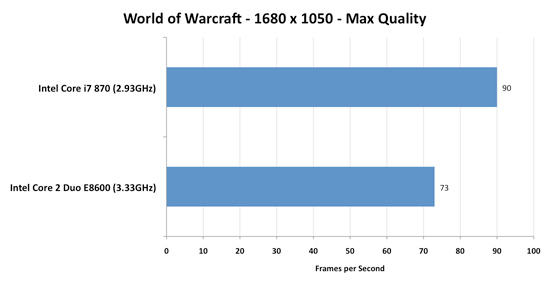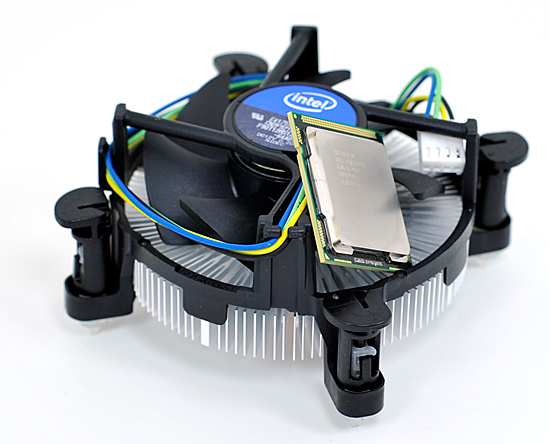Intel's Core i7 870 & i5 750, Lynnfield: Harder, Better, Faster Stronger
by Anand Lal Shimpi on September 8, 2009 12:00 AM EST- Posted in
- CPUs
Lynnfield's Turbo Mode: Up to 17% More Performance
Turbo on Bloomfield (the first Core i7) wasn't all that impressive. If you look back at our Core i7 article from last year you'll see that it's responsible for a 2 - 5% increase in performance depending on the application. All Bloomfield desktop CPUs had 130W TDPs, so each individual core had a bit more breathing room for how fast it could run. Lynnfield brings the TDP down around 27%, meaning each core gets less TDP to work with (the lower the TDP, the greater potential there is for turbo). That combined with almost a full year of improving yields on Nehalem means that Intel can be much more aggressive with Turbo on Lynnfield.
| SYSMark 2007: Overall | Dawn of War II | Sacred 2 | World of Warcraft | |
| Intel Core i7 870 Turbo Disabled | 206 | 74.3 fps | 84.8 fps | 60.6 fps |
| Intel Core i7 870 Turbo Enabled | 233 | 81.0 fps | 97.4 fps | 70.7 fps |
| % Increase from Turbo | 13.1% | 9.0% | 14.9% | 16.7% |
Turbo on Lynnfield can yield up to an extra 17% performance depending on the application. The biggest gains will be when running one or two threads as you can see from the table below:
| Max Speed | Stock | 4 Cores Active | 3 Cores Active | 2 Cores Active | 1 Core Active |
| Intel Core i7 870 | 2.93GHz | 3.20GHz | 3.20GHz | 3.46GHz | 3.60GHz |
| Intel Core i7 860 | 2.80GHz | 2.93GHz | 2.93GHz | 3.33GHz | 3.46GHz |
| Intel Core i5 750 | 2.66GHz | 2.80GHz | 2.80GHz | 3.20GHz | 3.20GHz |
If Intel had Turbo mode back when dual-cores first started shipping we would've never had the whole single vs. dual core debate. If you're running a single thread, this 774M transistor beast will turn off three of its cores and run its single active core at up to 3.6GHz. That's faster than the fastest Core 2 Duo on the market today.

WoW doesn't stress more than 2 cores, Turbo mode helps ensure the i7 870 is faster than Intel's fastest dual-core CPU
It's more than just individual application performance however, Lynnfield's turbo modes can kick in when just interacting with the OS or an application. Single threads, regardless of nature, can now execute at 3.6GHz instead of 2.93GHz. It's the epitomy of Intel's hurry up and get idle philosophy.
The ultimate goal is to always deliver the best performance regardless of how threaded (or not) the workload is. Buying more cores shouldn't get you lower clock speeds, just more flexibility. The top end Lynnfield is like buying a 3.46GHz dual-core processor that can also run well threaded code at 2.93GHz.
Take this one step further and imagine what happens when you have a CPU/GPU on the same package or better yet, on the same die. Need more GPU power? Underclock the CPU cores, need more CPU power? Turn off half the GPU cores. It's always availble, real-time-configurable processing power. That's the goal and Lynnfield is the first real step in that direction.
Speed Limits: Things That Will Keep Turbo Mode from Working
As awesome as it is, Turbo doesn't work 100% of the time, its usefulness varies on a number of factors including the instruction mix of active threads and processor cooling.
The actual instructions being executed by each core will determine the amount of current drawn and total TDP of the processor. For example, video encoding uses a lot of SSE instructions which in turn keep the SSE units busy on the chip; the front end remains idle and is clock gated, so power is saved there. The resulting power savings are translated into higher clock frequency. Intel tells us that video encoding should see the maximum improvement of two bins with all four cores active.
Floating point code stresses both the front end and back end of the pipe, here we should expect to see only a 133MHz increase from turbo mode if any at all. In short, you can't simply look at whether an app uses one, two or more threads. It's what the app does that matters.
There's also the issue of background threads running in the OS. Although your foreground app may only use a single thread, there are usually dozens (if not hundreds) of active threads on your system at any time. Just a few of those being scheduled on sleeping cores will wake them up and limit your max turbo frequency (Windows 7 is allegedly better at not doing this).
You can't really control the instruction mix of the apps you run or how well they're threaded, but this last point you can control: cooling. The sort-of trump all feature that you have to respect is Intel's thermal throttling. If the CPU ever gets too hot, it will automatically reduce its clock speed in order to avoid damaging the processor; this includes a clock speed increase due to turbo mode.

Lynnfield and its retail cooler
The retail cooler that ships with the Core i7 is tiny and while it's able to remove heat well enough to allow the chip to turbo up, we've seen instances where it doesn't turbo as well due to cooling issues. Just like we recommended in the Bloomfield days, an aftermarket cooler may suit you well.
Lynnfield: Made for Windows 7 (or vice versa)
Core Parking is a feature included in Windows 7 and enabled on any multi-socket machine or any system with Hyper Threading enabled (e.g. Pentium 4, Atom, Core i7). The feature looks at the performance penalty from migrating a thread from one core to another; if the fall looks too dangerous, Windows 7 won't jump - the thread will stay parked on that core.
What this fixes are a number of the situations where enabling Hyper Threading will reduce performance thanks to Windows moving a thread from a physical core to a logical core. This also helps multi-socket systems where moving a thread from one core to the next might mean moving it (and all of its data) from one memory controller to another one on an adjacent socket.
Core Parking can't help an application that manually assigns affinity to a core. We've still seen situations where HT reduces performance under Windows 7 for example with AutoCAD 2010 and World of Warcraft.
With support in the OS however, developers should have no reason to assign affinity in software - the OS is now smart enough to properly handle multi-socket and HT enabled machines.










343 Comments
View All Comments
Genx87 - Tuesday, September 8, 2009 - link
But after looking at the gaming benchmarks. I am wondering if the i5 is worth the cost to upgrade from an E8400? The best I could come up with from the graphs was the Q9560@3Gz or the E8600. In most of the games they were within a few % points. Ill have to see how the i5 does with the new round of cards from AMD\Nvidia before making a decision if I am going to build a new machine or just upgrade the GPU this winter.Kaleid - Tuesday, September 8, 2009 - link
Do like I do. Buy a better GPU. I'll stick to my e8400 at least until the 32nm CPU's arrive.And according to the guru3d review overclocking makes dramatically increases power consumption during load:
"Once we overclock to 4.1 GHz... the power consumption all of a sudden is 295 Watts (!), so an additional 1200 MHz of power is costing us an additional 133 Watts."
http://www.guru3d.com/article/core-i5-750-core-i7-...">http://www.guru3d.com/article/core-i5-7...re-i7-86...
papapapapapapapababy - Tuesday, September 8, 2009 - link
"the lowest Lynnfield is a faster gaming CPU than Intel's fastest dual-core: the E8600"bullshit. the E8600 has higher minimum frame rates umm know "when it matters the most"
http://images.anandtech.com/reviews/cpu/intel/lynn...">http://images.anandtech.com/reviews/cpu/intel/lynn...
scooterlibby - Tuesday, September 8, 2009 - link
Nice review. Lynnfield seems like a great deal too for people building a new system, but from a gaming standpoint, I don't see enough performance difference to upgrade my overclocked e8400 setup. Guess it'll be Sandybridge for me!rbbot - Tuesday, September 8, 2009 - link
What is the maximum memmory you can fit onto a P55 chipset? I notice the Gigabtye board has 6 dimms but their website still says Max 16Gb?Is there a 16Gb chipset limit? Would it increase once those new high-capacity dimms from samsung make an appearance?
the machinist - Tuesday, September 8, 2009 - link
I really don't know what to make of all this. I am about to buy i7 920 and over clock it to 3.6GHZ and then sometime next year upgrade the CPU to i9 6 core on LGA 1366. SLI does not interest me... cores/threads and clock speed are my main concern for 3d rendering.Is there any reason for someone like me to get this new platform instead? Please advice me.
rsher - Tuesday, September 8, 2009 - link
I wish I had an answer for you. I am in the same situation. If you do get a good reply please post it so I could figure out what to buy..BTW what is the i9 CPU?I have some time before I need to upgrade. HAve you considered using the Xenon processors... I use MAX 2010..
rSher
.
the machinist - Tuesday, September 8, 2009 - link
rSher Xeon are overkill these days considering the price premium. Single socket CPUs are so powerful these days that I just don't see the bang for the buck when it comes to Xeons. i7 920 over clocked matches some of the mid level Xeons anyway. If I was minting it and rendering only then I would get pair of high end XeonsRegarding your other question....
i9 will be 6 core version that will come out next year and you can use them on LGA1366 Mobos. I think a 8 core version will come out too. They will be expensive but by the time I decide to upgrade they should be less expensive.
PassingBy - Tuesday, September 8, 2009 - link
Can get single socket Xeon machines as well. The reason that professional users often prefer them is for ECC support. Up to you whether that matters for your applications. Naturally, for servers, ECC is the norm and that is also the situation for most professional workstations. Xeons can overclock as well, perhaps sometimes even better than the desktop equivalents, but professional users rarely overclock.Ann3x - Tuesday, September 8, 2009 - link
In some respects a great article. However the assertation that anything below the top end 1336 cpus are pointless is pretty obsurd.As others have stated the headroom and potential overclock of ANY d0 920 easily beats these new processors.
As it is, i7s are aimed at enthusiasts. FOR AN ENTHUSIAST *ie someone willing to tweak and OC* the 920 is still by fast the best bang for buck choice.
The new platform is only better if no tweeking is carried out (ie if youre not a technical user).
Therefore were left with a column aimed at technical users saying something that is only relevant to non technical users. At best its a gross simplification. As worst its missleading.
Yes, the new platform is good for the mass market, yes its exciting. However keep some perspective with your audience, the i7 920 is still BY FAR the best performance value for money CPU if you have the knowledge required to get the most out of it (as the majority of people buying X58 do).